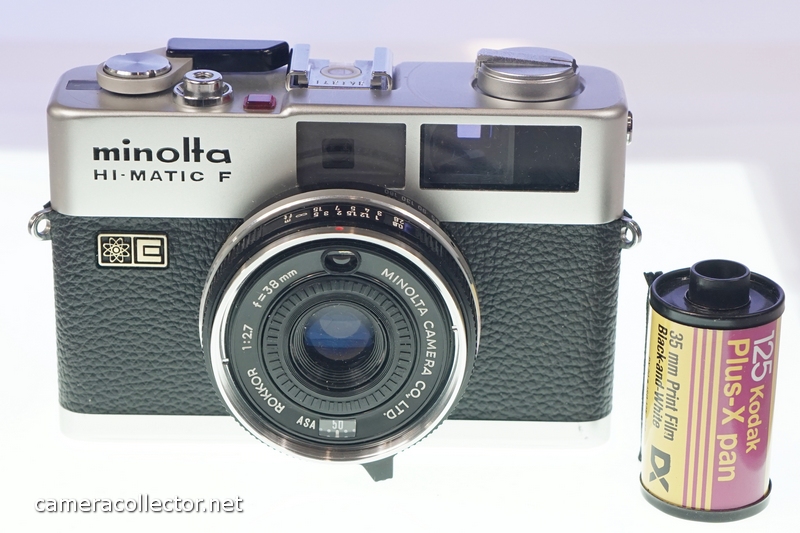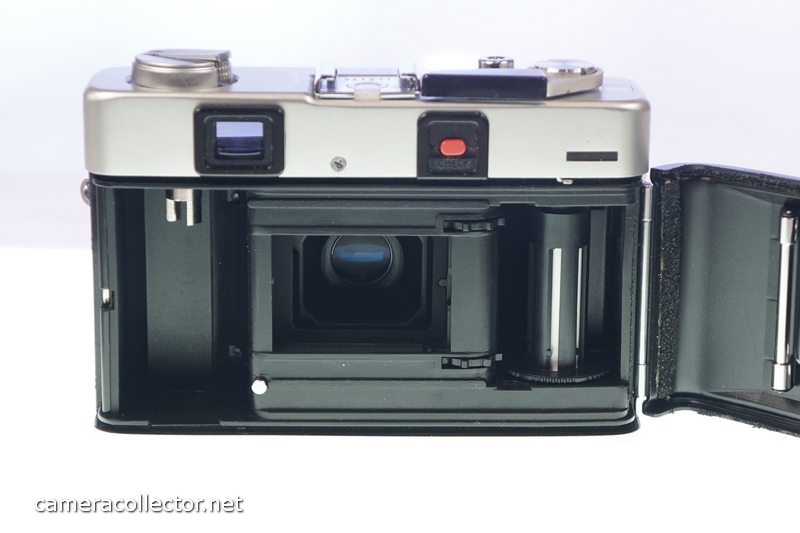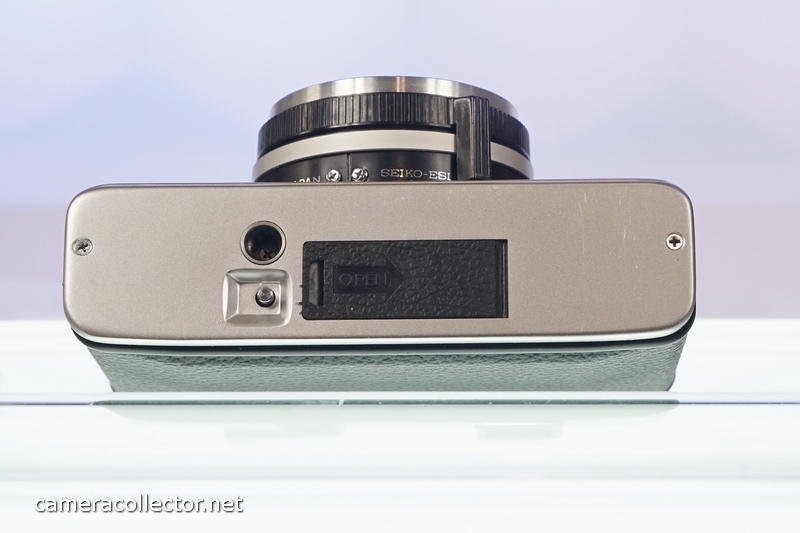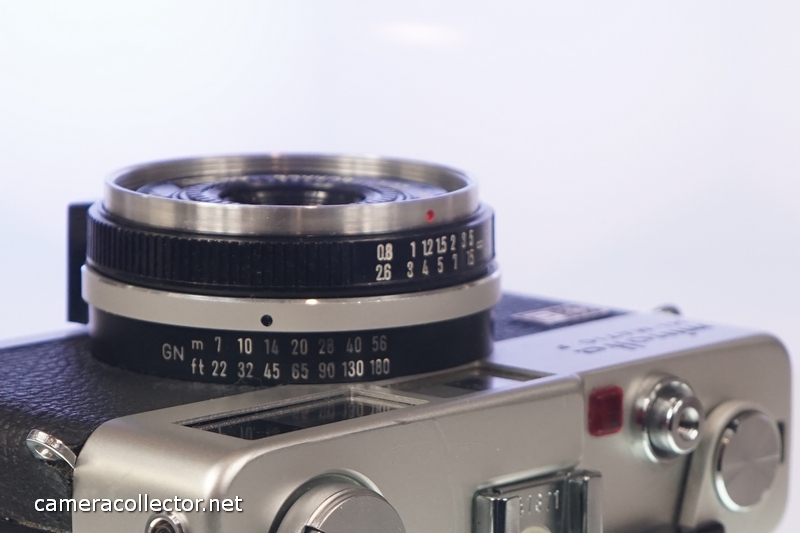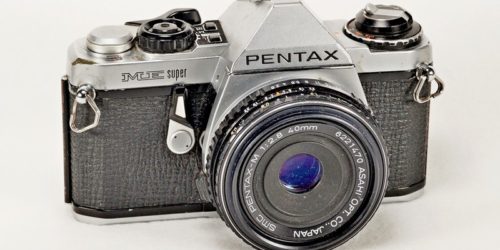Minolta Hi-Matic F
Minolta Hi-Matic F
In the middle of the Hi-Matic camera line, Minolta shifted its focus from the classic Hi-Matic manual cameras towards low-end models, such as the 1969 Hi-Matic C. The C was a questionable camera, intended to be easy to use for beginners, but it seems to have missed the mark on all fronts. Using today’s terms, it was meant to be a point-and-shoot camera, but there was still a long way to go for being just that.
Shortly after the C, Minolta had offered two models, much alike, the 1971 Hi-Matic E and the 1972 Hi-Matic F, the latter being the subject of this article. The E was a tad better specced, with a 1.7/40 lens, and the F had a plebeian 2.7/38 lens. I don’t have an E, but from what I read, the lens was the key difference between the two. What I take from that is that the F was meant for the same market as the C, and to rehash demand was sold just under the C price.
The Hi-Matic F seemed to be very popular, judging from the number of units offered on eBay at any given time, and from the wealth of online articles about it. Few cameras enjoy so much information, suggesting it had a broad user base. Common observations in most articles are:
- The camera source, mostly found at thrift stores, at a paltry cost.
- The shutter speed, ranging from 4 to 1/724 sec. It is a fact that holds no significance beyond curiosity, as the camera is fully automatic and sets the speeds at its discretion.
- Anguish about battery replacement.
The camera came in two versions, in chrome or black top, and had a cousin, the all black Hi-Matic FP, that added a self-timer.
The F had succeeded where the C failed. It is an easy-to-use camera; add autofocus, and you have a modern point-and-shoot model. It is tiny and relatively lightweight, and as cute as a puppy. As an added benefit, it had dropped the annoying picture-in-picture feature and the oddly positioned in-viewer metering scale found on the 11 and C models, so one could concentrate on just composing the image.
All it takes to take a picture is to set the film speed at the dial at the front of the lens, set the distance, aim, and shoot. No settings to worry about, the camera does the thinking. With a mounted flash gun, the camera shifts into flash mode, according to the GN values set at the dial closest to the body.
The downside is that the camera is entirely battery-dependent. Without a live battery, it can not be used. To mitigate this issue, a battery check button is available, which, with a sufficient battery, will illuminate a red light on top and display a sliver of red light within the viewer. Note that the circuit activates with a trigger half-press, so battery life is preserved.
- The camera body is smallish, will fit nicely in a small hand, yet feels just right in my hands, of a 6’2″ frame. The body is beautifully finished, with both skin and metal parts still immaculate for a 53-year-old camera.
- The top features a miniature winding lever that pulls from the top, as it sits flush with the body. Travel is shorter than earlier models. A red lens lights up with a press of the battery check button. Hot accessory shoe and pull-out folding rewind lever that doubles as a back release. The shoe will detect a mounted flash gun and put the camera in flash mode.
- Back has the said battery check button and a slot that turns red when film is loaded, a feature inherited from earlier Hi-Matic models.
- The viewer is large and clear, featuring a fixed parallel frame that is almost at the edges. As such, you’ll need to hunt for it. No meter scale or needle. A hairstring of red light appears with a press of the battery check button, which I guess is a reflection of the top red lens. The focusing patch is too bright to my taste.
- The front has an atom symbol with a stylized ‘E’, which means what it means.
- There is no self-timer. The sync port is side-mounted.
- On the lens assembly:
- Closest to the body is the fixed GN scale, with a smooth selecting ring by it, marked with a dot. The GN is the ability of the flash gun, and the setting of which should be taken from the value marked on the flash gun used.
- Next is the coupled rangefinder focusing dial, marked in meters and feet. It has a short travel time, yet it’s easy to focus. A finger rest is easy to grasp with a left-hand finger.
- At the front end of the lens assembly are the CdS meter lens and the film speed selector, marked ASA, with the value displayed in a window at the bottom. The selector is a serrated flat ring around the lens; it takes two fingers to change. The ring is stiff, so be careful not to over-push, or your finger might land on the lens.
- The bottom features the battery port, which has an easy-to-slide-open cover. Battery polarity is well marked.
- The original battery was a mercury #640, which is no longer available. As mentioned above, there are lengthy discussions and suggestions for current replacements. To be practical, there are two simple options. First, there is a same-size battery, an alkaline 640, at 1.5V, that is freely available online. The downside is the price, around US$10 each, and it takes two. A better option is to invest in custom adapters for an AG13 battery, available on Amazon or eBay, and also cheaper on AliExpress or other Chinese outlets. I prefer the second option, as further replacement batteries would be at the cost of an AG13, hence cheaper. The electronics are designed for 1.35V, whereas the current batteries are 1.5V, resulting in auto exposure being off. It would be prudent to scarify a roll or two, compensating with the film speed settings to achieve the correct exposure.
For the collector, this model is freely available at a low cost. It is a pretty camera, so that I would add it to the Minolta shelf. For the shooter, considering it has no user settings, I would pass.
| Camdex list number | 5337 |
| Brand | Minolta |
| Hi-Matic F | |
| Manual | Butkus Massimo Scotti |
| Value | Hi-Matic F Hi-Matic F Black Hi-Matic FP |
| Format | 35mm |
| Introduced | 1972 |
| AKA | |
| Country | Japan |
| Qty made | |
| Initial price | |
| Currency | |
| Type | Rangefinder |
| Body material | Metal |
| Mode | Auto |
| Weight | 360 gr, Body with lens |
| Class average weight | 630 gr, Body with lens |
| ASA range | 25-500 |
| Kit lens | 2.7/38 |
| Lens make | Rokkor |
| Filter size | 46 mm |
| Lens mount | Fixed lens |
| Mount size | N/A |
| Aperture | |
| Shutter | Leaf |
| Shutter make | Seiko ESL |
| Trigger | On top |
| Winder | Lever |
| Shutter cocking | Lever on body |
| Light meter | CdS, coupled |
| Loc | No |
| Speeds | Auto |
| Mirror | N/A |
| Viewer | Coupled rangefinder |
| DOF preview | No |
| Exposure lock | No |
| Exposure compensation | No |
| Shoe | Hot |
| External sync | X |
| Sync speed | |
| Timer | No |
| Battery, original | 3106.net aperturereview.com |
| Battery, replacement | Adapter |
| Battery voltage | 1.5 |
| Integral flash | None |
| Other | |
| More | |
| Service / repair links | See camerlog.com |

